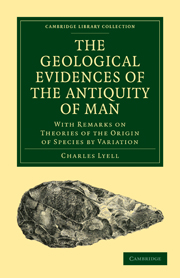 The Geological Evidences of the Antiquity of Man
The Geological Evidences of the Antiquity of Man Book contents
- Frontmatter
- Contents
- CHAPTER I INTRODUCTION
- CHAPTER II RECENT PERIOD—DANISH PEAT AND SHELL MOUNDS—SWISS LAKE DWELLINGS
- CHAPTER III FOSSIL HUMAN REMAINS AND WORKS OF ART OF THE RECENT PERIOD
- CHAPTER IV POST-PLIOCENE PERIOD: BONES OF MAN AND EXTINCT MAMMALIA IN BELGIAN CAVERNS
- CHAPTER V POST-PLIOCENE PERIOD: FOSSIL HUMAN SKULLS OF THE NEANDERTHAL AND ENGIS CAVES
- CHAPTER VI POST-PLIOCENE ALLUVIUM AND CAVE DEPOSITS WITH FLINT IMPLEMENTS
- CHAPTER VII PEAT AND POST-PLIOCENE ALLUVIUM OF THE VALLEY OF THE SOMME
- CHAPTER VIII POST-PLIOCENE ALLUVIUM WITH FLINT IMPLEMENTS OF THE VALLEY OF THE SOMME—concluded
- CHAPTER IX WORKS OF ART IN POST-PLIOCENE ALLUVIUM OF FRANCE AND ENGLAND
- CHAPTER X CAVERN DEPOSITS, AND PLACE OF SEPULTURE OF THE POST-PLIOCENE PERIOD
- CHAPTER XI AGE OF HUMAN FOSSILS OF LE PUY IN CENTRAL FRANCE AND OF NATCHEZ ON THE MISSISSIPPI, DISCUSSED
- CHAPTER XII ANTIQUITY OF MAN RELATIVELY TO THE GLACIAL PERIOD AND TO THE EXISTING FAUNA AND FLORA
- CHAPTER XIII CHRONOLOGICAL RELATIONS OF THE GLACIAL PERIOD AND THE EARLIEST SIGNS OF MAN'S APPEARANCE IN EUROPE
- CHAPTER XIV CHRONOLOGICAL RELATIONS OF THE GLACIAL PERIOD AND THE EARLIEST SIGNS OF MAN'S APPEARANCE IN EUROPE—continued
- CHAPTER XV EXTINCT GLACIERS OF THE ALPS AND THEIR CHRONOLOGICAL RELATION TO THE HUMAN PERIOD
- CHAPTER XVI HUMAN REMAINS IN THE LOESS, AND THEIR PROBABLE AGE
- CHAPTER XVII POST-GLACIAL DISLOCATIONS AND FOLDINGS OF CRETACEOUS AND DRIFT STRATA IN THE ISLAND OF MÖEN, IN DENMARK
- CHAPTER XVIII THE GLACIAL PERIOD IN NORTH AMERICA
- CHAPTER XIX RECAPITULATION OF GEOLOGICAL PROOFS OF MAN'S ANTIQUITY
- CHAPTER XX THEORIES OF PROGRESSION AND TRANSMUTATION
- CHAPTER XXI ON THE ORIGIN OF SPECIES BY VARIATION AND NATURAL SELECTION
- CHAPTER XXII OBJECTIONS TO THE HYPOTHESIS OF TRANSMUTATION CONSIDERED
- CHAPTER XXIII ORIGIN AND DEVELOPMENT OF LANGUAGES AND SPECIES COMPARED
- CHAPTER XXIV BEARING OF THE DOCTRINE OF TRANSMUTATION ON THE ORIGIN OF MAN, AND HIS PLACE IN THE CREATION
- INDEX
CHAPTER XVI - HUMAN REMAINS IN THE LOESS, AND THEIR PROBABLE AGE
Published online by Cambridge University Press: 29 August 2010
- Frontmatter
- Contents
- CHAPTER I INTRODUCTION
- CHAPTER II RECENT PERIOD—DANISH PEAT AND SHELL MOUNDS—SWISS LAKE DWELLINGS
- CHAPTER III FOSSIL HUMAN REMAINS AND WORKS OF ART OF THE RECENT PERIOD
- CHAPTER IV POST-PLIOCENE PERIOD: BONES OF MAN AND EXTINCT MAMMALIA IN BELGIAN CAVERNS
- CHAPTER V POST-PLIOCENE PERIOD: FOSSIL HUMAN SKULLS OF THE NEANDERTHAL AND ENGIS CAVES
- CHAPTER VI POST-PLIOCENE ALLUVIUM AND CAVE DEPOSITS WITH FLINT IMPLEMENTS
- CHAPTER VII PEAT AND POST-PLIOCENE ALLUVIUM OF THE VALLEY OF THE SOMME
- CHAPTER VIII POST-PLIOCENE ALLUVIUM WITH FLINT IMPLEMENTS OF THE VALLEY OF THE SOMME—concluded
- CHAPTER IX WORKS OF ART IN POST-PLIOCENE ALLUVIUM OF FRANCE AND ENGLAND
- CHAPTER X CAVERN DEPOSITS, AND PLACE OF SEPULTURE OF THE POST-PLIOCENE PERIOD
- CHAPTER XI AGE OF HUMAN FOSSILS OF LE PUY IN CENTRAL FRANCE AND OF NATCHEZ ON THE MISSISSIPPI, DISCUSSED
- CHAPTER XII ANTIQUITY OF MAN RELATIVELY TO THE GLACIAL PERIOD AND TO THE EXISTING FAUNA AND FLORA
- CHAPTER XIII CHRONOLOGICAL RELATIONS OF THE GLACIAL PERIOD AND THE EARLIEST SIGNS OF MAN'S APPEARANCE IN EUROPE
- CHAPTER XIV CHRONOLOGICAL RELATIONS OF THE GLACIAL PERIOD AND THE EARLIEST SIGNS OF MAN'S APPEARANCE IN EUROPE—continued
- CHAPTER XV EXTINCT GLACIERS OF THE ALPS AND THEIR CHRONOLOGICAL RELATION TO THE HUMAN PERIOD
- CHAPTER XVI HUMAN REMAINS IN THE LOESS, AND THEIR PROBABLE AGE
- CHAPTER XVII POST-GLACIAL DISLOCATIONS AND FOLDINGS OF CRETACEOUS AND DRIFT STRATA IN THE ISLAND OF MÖEN, IN DENMARK
- CHAPTER XVIII THE GLACIAL PERIOD IN NORTH AMERICA
- CHAPTER XIX RECAPITULATION OF GEOLOGICAL PROOFS OF MAN'S ANTIQUITY
- CHAPTER XX THEORIES OF PROGRESSION AND TRANSMUTATION
- CHAPTER XXI ON THE ORIGIN OF SPECIES BY VARIATION AND NATURAL SELECTION
- CHAPTER XXII OBJECTIONS TO THE HYPOTHESIS OF TRANSMUTATION CONSIDERED
- CHAPTER XXIII ORIGIN AND DEVELOPMENT OF LANGUAGES AND SPECIES COMPARED
- CHAPTER XXIV BEARING OF THE DOCTRINE OF TRANSMUTATION ON THE ORIGIN OF MAN, AND HIS PLACE IN THE CREATION
- INDEX
Summary
Nature and Origin of the Loess.
INTIMATELY connected with the subjects treated of in the last chapter, is the nature, origin, and age of certain loamy deposits, commonly called loess, which form a marked feature in the superficial deposits of the basins of the Rhine, Danube, and some other large rivers draining the Alps, and which extend down the Rhine into the Low Countries, and were once perhaps continuous with others of like composition in the north of France.
It has been reported of late years that human remains have been detected at several points in the loess of the Meuse around and below Maestricht. I have visited the localities referred to; but, before giving an account of them, it will be desirable to explain what is meant by the loess, a step the more necessary, as a French geologist, for whose knowledge and judgment I have great respect, tells me he has come to the conclusion that ‘the loess’ is ‘a myth,’ having no real existence in a geological sense, or as holding a definite place in the chronological series.
No doubt it is true that in every country, and at all geological periods, rivers have been depositing fine loam on their inundated plains in the manner explained above at p. 34, where the Nile mud was spoken of. This mud of the plains of Egypt, according to Professor Bischoff's chemical analysis, agrees closely in composition with the loess of the Rhine.
- Type
- Chapter
- Information
- The Geological Evidences of the Antiquity of ManWith Remarks on Theories of the Origin of Species by Variation, pp. 324 - 340Publisher: Cambridge University PressPrint publication year: 2009First published in: 1863


